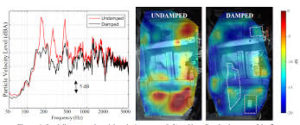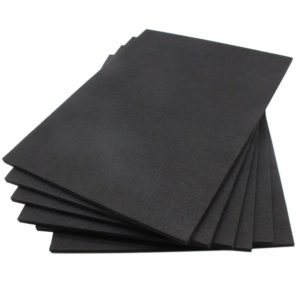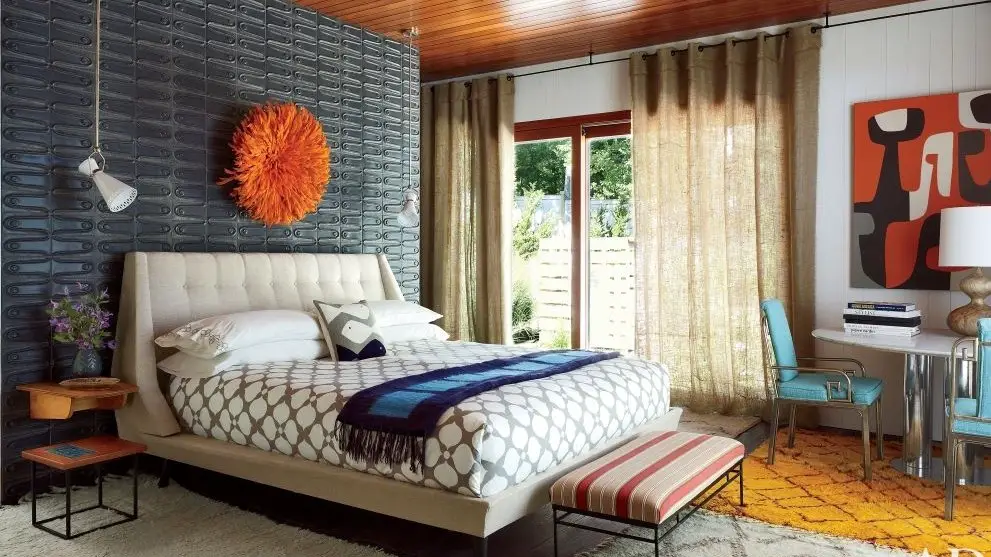Before I get into what is soundproofing?. Let’s first define what sound is. Sound is simply defined as a vibration propagating through the matter surrounding us. Matter in simple terms is defined as anything that can occupy space. This could be solid materials, liquid, or gas.
We hear the sound around us because everything surrounding us is matter. The air in the room, the walls, windows, ceiling, doors, and the floor are all matter.

In order to create a sound that the human ears can hear, sound energy has to move the molecules of the substance through which it is traveling and create sound waves that spread in a circular pattern like the ripples in a pond.
As these sound waves travel through a distance, their intensity becomes lesser intense naturally. Sound can be a wanted noise or unwanted noise.
Sound can be likened to that of water. It doesn’t have shape or form. Instead, it molds itself to its surroundings, like water can be absorbed by some materials and contained by others.
This is why sound absorbing and soundproofing materials can stop the transfer of sound within a space, or from one space to another.
This now brings us to:
What is Soundproofing?
Soundproofing is a means of reducing any unwanted noise (sound waves) coming from a specific source.
Soundproofing can be used to reduce the transmission of unwanted direct sound waves from the source to an involuntary listener through the use of distance and intervening objects in the sound path.
Sound pollution has become predominantly high in urban areas, soundproofing is also becoming popular in residential structures, especially in multi-family structures like apartments where walls are shared and in industrial or public transport areas.

There are several basic approaches to reducing sound: one is increasing the distance between the source and the receiver.
This can be done by using noise barriers to reflect or absorb the energy of the sound waves, using damping structures such as sound baffles or using active antinoise sound generators.
Soundproofing can suppress unwanted indirect sound waves such as reflections that cause echoes and resonances that cause reverberation.
The type of soundproofing you will need depends on the type of noise you are trying to reduce. Whether it is impact or airborne.
Quieter noise can be controlled by the used of sound absorbers, while the more penetrating impact noise may need more drastic measures in order to combat it.
This could be done by creating a room within a room using stud walls. You could also soundproof the floors, ceilings, doors as well.
How does Soundproof Work?
Soundproofing works by using materials that either reduce or absorb sound. While sound usually cannot be blocked completely, substantial noise reduction is possible.
Soundproofing works by tackling the two ways in which sound travels.
The most common types of noise are airborne sound, this occurs when soundwaves, caused by something like someone speaking or music being played, travel through the air.
The second way sound travels is as impact noise, this is when sound vibrations travel through a solid structure such as floorboards, walls, floors, etc
Benefits of Soundproofing
No one wants noise pollution around them. As such, there are great benefits of soundproofing your room or any space that you want no sound or noise inside. Some benefits include:
- Reduces the transmission of direct unwanted sound waves
- Dispels indirect unwanted sound waves
Soundproofing Related Terminologies
Distance: This is the space between the noise source and the receiver. Sound pollution decreases with increasing distance from the source to the receiver.
Absorption: This simply means absorbing the sound wave. In this process, the vast majority of the sound wave is absorbed by the absorbing material. This sound wave is then converted to heat energy. The type of material used would determine how much sound is absorbed.
Damping: This in a simple definition means to reduce resonance in a room by either absorption or redirection (reflection or diffusion). Redirection makes the unwanted sound either harmless or beneficial by reducing coherence.
While absorption will reduce the overall sound wave energy level.
Reflection: The reflected angle of a sound wave when it hits a surface varies from one medium to another. When sound waves hit a medium, the reflection of that sound is dependent on dissimilarity of the surfaces it comes in contact with.
Diffusion: Another important terminology in soundproofing. This is used to effectively eliminate pockets of noise in a room. When reflections from hard surfaces like a concrete floor are giving people a problematic echo, then an acoustic diffuser may be applied to the surface to help scatter the sound in all directions to reduce its intensity.
Porous Absorbers: These are typically open-cell rubber foams or melamine sponged. they absorb noise by friction within the cell structure. Porous absorbers are a highly effective treatment of noise across a broad range of medium to high frequencies.

The exact absorption profile of a porous open cell foam will be determined by a number of factors including the following:
- Cell size
- Tortuosity
- Porosity
- Material thickness
- Material density
Resonant Absorbers: These work by damping a sound wave as it is reflected. Resonant panels and other resonant absorbers unlike porous absorbers, work most effective at low-medium frequencies. The resonant absorber must always be matched to a narrow frequency range.
Noise Cancellation: This process is a simple yet innovative and effective way of controlling noise in a room. It is an active noise control method used to control destructive interferences.
How this works is that the sound that is causing the problem is picked up by a microphone and analyzed by a computer. Then a sound wave with opposite polarity( 180 degrees out of phase) is created through the speaker to minimized the effect of the problematic sound.
Types of Soundproofing
Soundproofing falls into three types. Each type will be discussed in detail below.
- Residential Soundproofing
- Commercial Soundproofing
- Automotive Soundproofing
Residential Soundproofing:
This usually involves keeping unwanted noise out of homes. Home spaces such as bedrooms, living rooms, home theatre, home offices or any space within the home where one does not want unwanted sound waves inside.
Many people often accomplish this by soundproofing their doors, windows, walls or even the floor.
The main focus of residential soundproofing in existing structures is usually the windows and doors. It is always better to use solid wood doors as sound barriers than hollow doors.
Soundproof curtains can also be used to dampen the sound either through the use of heavy materials or through the use of air chambers also known as air chambers. The air chambers can be single, double or triple honeycomb designs.
The thickness of the glass will also play a role when diagnosing sound leakage. Double-pane windows achieve somewhat greater sound damping than single-pane windows when well sealed into the opening of the window frame and wall.
You can also still soundproof by installing a second interior window. The exterior window remains in the same place while you install a hung or slide window within the same window opening.

In the USA, the FAA offers sound reducing for homes that fall within a noise contour where the average decibel level is 65 decibels. It is part of their Residential Sound Insulation Program. The program provides Solid-core wood entry doors plus windows and storm doors.
Similar Reads:
Affordable Ways to Soundproof a bedroom wall
Easy Ways to Soundproof a bedroom floor
Ways to Soundproof a bedroom ceiling without construction
Tips on how to soundproof a bedroom door
Commercial Soundproofing:
Commercial soundproof involves keeping unwanted noise out of commercial properties such as schools, offices, health centers and the like. Places where many people convey for a common purpose. In the US, OSHA has requirements regulating the length of exposure of workers to certain levels of noise
In fact, research has shown that soundproofing your office can improve productivity in the office. Employees are easily distracted by phones ringing, other employees conversations, etc.
If you want more productivity from your employees, then soundproofing the office is of paramount importance – especially if your office is in a noisy environment.
Noise soundproofing is important in mitigating people from losing their concentration and focus from their work project. It is also important to keep confidential conversations secure to the intended listeners.
At the very least, many offices are soundproofing their conference rooms to avoid distractions. This is to ensure meetings and conferences are carried out undistracted.
Automotive Soundproofing:
Noise caused by engines, exhausts, and motors often needs soundproofing to keep them quiet to operate. Automotive soundproofing is used to reduce or completely eliminate the noise coming from these equipment.
There are many complex noises created within vehicles that change with the driving environment and speed at which the vehicle travels. Significant noise reductions of up to 8 dB can be achieved by installing a combination of different types of soundproofing materials.
The unique thing about this type of soundproofing is that, it works effectively against a wide range of frequencies.
To accomplish automotive soundproofing, a variety of materials can be used such as absorbers, dampers and barriers are used.
What Materials are Used for Soundproofing?
So now you know what soundproofing is but you are curious about what materials are used for soundproofing. There are different soundproofing materials available today. It all depends on your situation and your pocket. Some of the materials you can use for soundproofing include:
- Acoustic sound panels
- Noise absorbers
- Noise and sound isolation foams
- Sound barrier materials
- Soundproofing foam
- Mass loaded vinyl
- Soundproof curtains
- Hanging waffles
- Acoustic fiberglass
How Much Does It Cost to Soundproof a Room?
The question as to how much it can cost you to soundproof a room will depend on the intensity of the sound waves and the direction of the sound. The cost will involve the materials, the labor and the tools you will need.
For the labor, it will cost you anywhere between $200 to $300 for a professional. They don’t come cheap. The tools will cost you somewhere between $20 to $40. The materials you will need will be between $150 to $280.
If you want to cut down the costs, maybe you should buy the materials and do it yourself that is if you are a bit handy.
Final Words
When it comes to the question – what is soundproofing?. I believe this post has explained it to help you understand better what soundproofing is. How soundproofing works and the terminologies used so that when someone mentions them you don’t get confused.
Also, the types of soundproofing and how much it might cost you to soundproof a room are also mentioned above. Noise pollution has become a big challenge in this modern world. However, there are many ways you can eliminate these noises or reduce them to such that you don’t get affected. Accessive noise can cause you to lose your hearing and get other sleep-related illnesses.
So, it is important to take the necessary steps to soundproof the affected areas around you.
- How to Chew Quietly While Eating-Effective Tips - April 14, 2023
- Why is My Clutch Pedal Squeaking – Causes & Fixes - April 14, 2023
- Propane Tank Making Hissing Noise (Solved) - February 25, 2023
